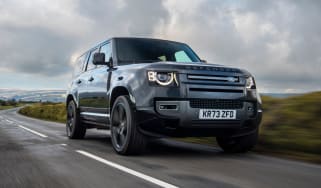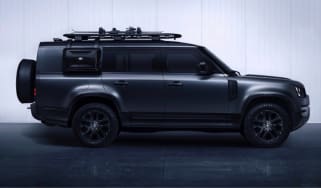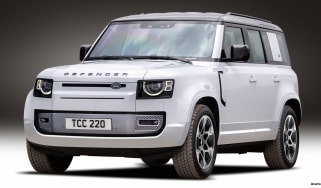Land Rover Defender review
Land Rover has aced the latest Defender, which combines rugged go-anywhere ability with new levels of civility

If there was a vehicle that better represented the might of modern British engineering we’d be hard pressed to think of one, because the Land Rover Defender is simply brilliant. After a few years on sale, it has silenced the doubters and proven itself worthy of the famous name. It’s a significantly more modern and comfortable car than before, widening its appeal to the extremes of SUV buyers, whether that be as a practical family wagon, farmer-friendly workhorse or a glitzy city-dwelling luxury car.
But customers can be reassured that, regardless of the Defender’s new-found attributes, there’s still an almost unmatched level of off-road ability core to its existence. Whether tackling the steepest of slopes or the highest of kerbs, the Defender’s got it covered.
You’ll have to pay handsomely for the privilege though, as the Defender is an expensive car, and there are all kinds of other rivals to consider, but none possess that unique sense of cool and personality that comes with a Land Rover Defender.
About the Land Rover Defender
It took Land Rover a long time to replace the iconic Defender 4x4, but when it did there was no messing about. There was some initial consternation about some of the fundamental changes, things like the move to a unibody chassis design and a complete reliance on electronics to control its sophisticated four-wheel drive system, but there’s no doubt the latest model can wear its Defender badges with pride. We think it's an icon reborn, and awarded it the title of Large Premium SUV of the Year at our 2022 New Car Awards.
More reviews
Car group tests
- Land Rover Defender vs Ineos Grenadier vs Ford Ranger Raptor: the ultimate off-road shootout
- The best long-term car tests 2022
Long-term tests
Road tests
- Land Rover Defender 130 Outbound 2024 review: goodbye extra seats, hello enormous boot
- New Land Rover Defender 130 P500 2024 review: plenty of space and power, but also rather excessive
- New Land Rover Defender 75th Limited Edition 2023 review
- New Land Rover Defender 130 2022 review
Used car tests
Underneath the equally retro and sleek exterior design, the latest Land Rover Defender is worlds apart from its more agricultural ancestor, which is for the better. The old car’s clunky solid axles have been replaced with a new independent system, paired to either steel coil springs or air, helping it ride more comfortably without giving up anything in terms of off-road ability. To drive a Defender long distances on the motorway is no longer a hardship, in fact, it’s now a brilliant long-legged cruiser.
But it wasn’t only consumers demanding change, because as emissions and safety regulations continue to tighten, so was the reality of keeping the old car ahead of these no longer plausible. That said, no modern Defender could reasonably be called frugal, but depending on your usage the vast spread of diesel, petrol and plug-in hybrid powertrain options means there’s almost certainly a powertrain option to suit your needs.
The interior is now also worth a mention as it’s a real highlight. Without appearing too fancy or delicate, it still feels very well built and is very practical. As with the engines and body styles, versatility is the cabin’s real ace, with five, six, seven or even eight-seat options available. Interior tech is also very good, especially when fitted with the larger Pivi Pro infotainment system, and the interior trim can be finished in everything from rugged and hard wearing technical fabrics, right through to Range Rover-like leathers and polished woods.
This wide range of abilities means that the competition for the new Defender is widespread. Rival off-road specialists such as the Jeep Wrangler and Mercedes G-Class both retain a body-on-frame chassis and the relevant advantages and disadvantages they carry. The Jeep is fairly archaic and doesn’t at all match the Land Rover’s day-to-day comfort, but Merc’s more expensive G-Class gets much closer, and comes with an even more desirable image, if that’s what you’re concerned about. Regardless, both these rivals might be able to challenge the Defender off-road, but neither is so good on it.

There are also mainstream challengers in the form of the Toyota Land Cruiser, which has just itself been reimagined in a retro-inspired all-new model coming to the UK next year, plus the SsangYong Rexton. Those interested in using the Defender more as a family car might be tempted by luxury SUV rivals, such as the BMW X5, Volvo XC90, Mercedes-Benz GLE or Lexus RX.
If more rugged farm work is a key deliverable, there’s also the various double-cab pick-ups currently on sale, such as the Ford Ranger, Volkswagen Amarok and Toyota Hilux. All three deliver serious 4x4 ability and a more car-like driving experience than they used to, although again, none match the Defender in this regard. Land Rover is also all too aware of its own Discovery being cross-shopped.
Defender customers have a choice of three-door Defender 90, or five-door Defender 110 and 130 models, with the range starting from around £51,000 for a Commercial ‘Hard Top’ 90 version. You'll pay £10,000 more for a 90 passenger version, and another £10,000 or so for the five-door 110. The biggest 130 model, with lengthened bodywork to accommodate up to eight occupants or more cargo, starts at around £75,000, and each body shape has its own combination of powertrains, trims and options.
There are two diesel engines on offer for the entire Defender family: the D250 and D300 with 247bhp and 296bhp, respectively – both are versions of a 3.0-litre, six-cylinder in-line unit with mild-hybrid tech.
The petrol options are the 296bhp P300 four-cylinder and the 394bhp P400 in-line six with a mild-hybrid boost. There’s also a plug-in hybrid option for the 110 models, the 398bhp P400e, combining a four-cylinder petrol engine, e-motor and battery pack. This model delivers the best on-paper economy and lower CO2 emissions, but once out of electricity it can be extremely thirsty.
There’s also a supercharged V8 petrol option featuring JLR’s 5.0-litre engine with 518bhp in high-spec 90 and 110 models, plus a 496bhp verison of the same V8 engine on the top-spec 130. All Defenders use the same basic eight-speed auto transmission, plus selectable all-wheel drive, a low-range transfer case and locking differentials.
Trim levels include S, SE and HSE variants, with availability depending on which body and engine you choose. There’s also an opportunity to upgrade each of those to the X-Dynamic equipment line, followed by top-spec X versions. In addition, XS Edition models have recently joined the range, these mimic SE in terms of basic specification, the difference being a more on-road bias to the exterior styling by using body-colour for the lower bumpers, sills and arch surrounds.
The V8 model is the current flagship signified by the quad exhaust outlets and blue highlights around the brake calipers, with a final Carpathian Edition offering a bespoke grey paint-job and special interior finishes. The 130, meanwhile, has since received the rugged Outbound edition, blacking out the rear-most windows and removing the third row of seating, unlocking a simply massive cargo space.
For an alternative review of the Land Rover Defender, visit our sister site carbuyer.co.uk...



























